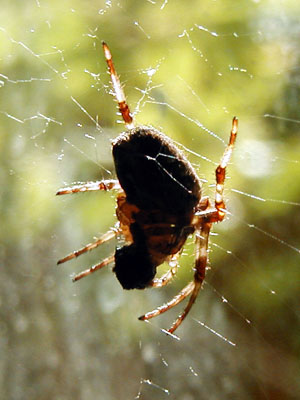Web Two Point Oh
Something I've always liked about the Pacific Northwest is what I call the Autumn of Orb Spiders—or, somewhat more properly, the Autumn of European Cross Spiders. In September and October, improbably large-bodied spiders suddenly appear everywhere, constructing classic spiral webs across seemingly any available span or opening. Many of these webs are engineering feats, made even more remarkable by the spiders' unwieldy, bulbous bodies. Around here, these webs aren't made by sleek, fast hunters; no, instead they're the work of critters whose body proportions could come out of a monster movie. (And, in fact, probably inspired a few.)

Orb spider enjoying lunch in the garage
Orb spiders are something of a navigation hazard this time of year in gardens and hiking trails, because they seem to unerringly make their webs at just about face-height to a human. So, you'll be walking along and suddenly you have a face full of web…and the feeling of a large, bulbous, clumsy arachnid trying to scurry somewhere safe.
On trails, I usually just carry a switch and lift any webs out of my way if I can't get around them. In doing so, I've often marveled at the sheer variety of markings on the spiders—some are just dull duns, browns, and greys, while others sport reds, oranges, yellows, pinks, and even blues.
But mostly I love watching them build webs. These arachnids have bodies that seem barely capable of walking, but they engineer incredibly strong—and often, incredibly large—webs. The process isn't very mysterious if you actually get to see an orb spider start its web. They climb to a high, relatively sturdy location, and they let fly with a strand of strong silk. That strand gets carried on breeze, wind, or air currents until it connects with another objects—at which point the spider tries to pull it taut. If it breaks loose or the far object isn't steady enough, the spider lets the strand go and tries again. If enough strands fail, they might move to a different spot.
But once they have a single line in place, they're good to go. The spiders travel back and forth on the first line, reinforcing it with additional silk. Then, they travel out a bit on the first line and begin a new length of silk, attached to the first line. Then, they scuttle along the first line to a further point, letting the new silk drop in a loose arc behind them. They then fasten the end to the first line: the result is a "loop" of loose silk hanging below the first taut line.
Then the spider lowers itself down the loop to its midpoint, connects a new line, and drops. The result is a Y-shaped beginning of a frame for a new web, with the nexus of the Y marking what will eventually be the center of the web.
It takes a few hours for an orb spider to finish a web, and they may stay in it for a few days, waiting for prey. As they capture prey—and debris—the web gets more and more torn apart. If a spider likes a spot, he (or she) will tear down a web and rebuild in the same place. Otherwise, they'll move on. I've seen orb spiders rebuild in the same place half a dozen times.
Spiders seem to measure the spacing of individual radii and strands on their webs with their own bodies; thus each web is appropriately sized for them to move along quickly, but it's probably quite difficult for them to manage on another spider's web.
One irony: I've seen orb spiders get tangled in their own webs. Once, when struggling with a wasp, I saw a spider become almost hopelessly entangled: she won the fight with the wasp, but didn't seem to be able to get loose from her web. It looked like she began eating the web to cut herself free, but wasn't able to get one of her rear legs loose. She stayed pinned there (outside my office window) dining on wasp for three days, that one leg trapped and pinning her in place. She'd struggle, pull, chew, and twist, but nothing worked. Then, one morning, she just got up on the seven remaining legs, began turning in circles, and twisted the trapped leg completely off, leaving it hanging in the web like some discarded doll part. Then she took down the web and rebuilt it in the same spot. She was there another month.
- Categories:
- Great Navel Battles
Hey, what's life without fine print?
